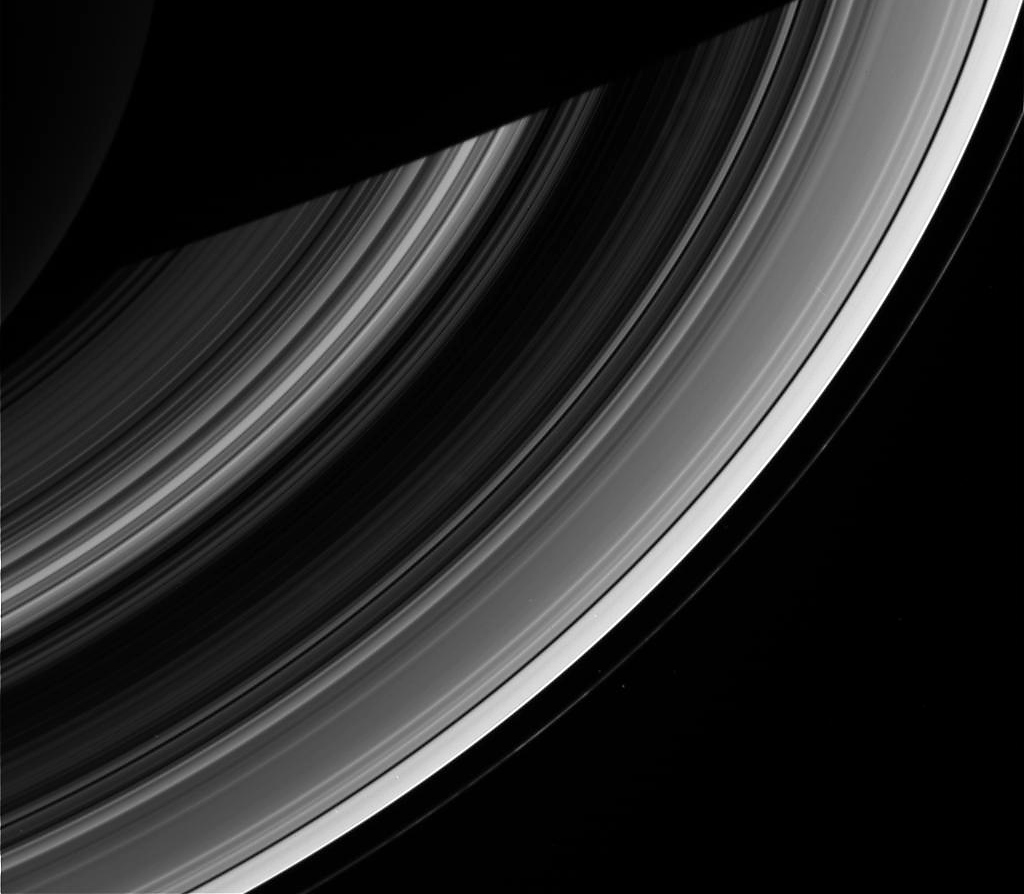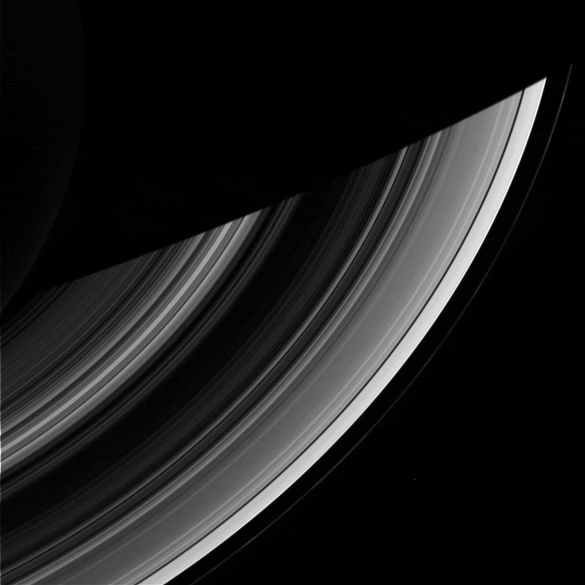Raw wide-angle Cassini image of Saturn’s rings (NASA/JPL/SSI)
Recently I posted an image of two of Saturn’s shepherd moons, Pandora and Prometheus, captured by Cassini in a face-off across the spindly F ring. Now here’s a much wider-angle view of the gas giant’s rings, seen by Cassini two days later on December 20, and the same two moons can still be seen staring each other down… two tiny points of light visible across the wavering line of the F ring at lower center.
This is just one raw image in a series of 56 that Cassini captured on the 20th, and I’ve combined them together to make a GIF animation — click below to watch:
Animation of Saturn’s rings made from raw images acquired by Cassini on Dec. 20, 2012 (NASA/JPL/SSI. Animation by J. Major)
 In the animation you can see Pandora and Prometheus promenade around Saturn (detail at right) as well as a “spoke” of light material moving within the inner dark edge of the A ring. Also many clumps are visible in the thin F ring — caused by embedded moonlets and the gravitational influence of the shepherd moons.
In the animation you can see Pandora and Prometheus promenade around Saturn (detail at right) as well as a “spoke” of light material moving within the inner dark edge of the A ring. Also many clumps are visible in the thin F ring — caused by embedded moonlets and the gravitational influence of the shepherd moons.
Saturn’s enormous shadow engulfs the entire ring system at the top of the scene.
Cassini was moving relative to Saturn while these images were captured so some background stars make brief appearances, as well as a couple of pixel flares and a cosmic ray hit. These are common in Cassini images.
See more news and images from the Cassini mission here.



It would be interesting to see a full-on/wider view showing the positions of the moons, spokes and condensations in a similar or longer animation? What relationships might their relative motions share?
A video animation would be better to show interactions of the ring with the little sattelites !
There is a bit of a relative motion issue. To what extent is the motion in the animation due to the rotation of the rings and what is due to the orbital motion of Cassini?
LC
There’s obviously a little of both; not only are the rings orbiting Saturn, but so is Cassini, which is also getting closer to the rings over the course of the animation. But since the F ring material can be seen exiting Saturn’s shadow, I would have to assume that most of the movement is due to the rings themselves.
Heh Jason , judging by the title , you must have little ones.
The wordings sound vageuly familiar to a rhyme my little one loves.
BTW how round are those rings ? Are they perfectly round or are they very slightly oval since they mostly go around Saturn’s equator.
Saturn’s majestic Rings seem to encircle the meaning of astonish. When the first Voyager made its fateful passage, that is what many felt, and still feel. Wonder! In shadow and light, from given angle of flight, through ever changing geometry of ringlet view, day and night – amazement and wonder, from world-encircling retinue! (Attendant moons too.)
Detailed as images have become (with all the dynamic, surreal features), imagine a real-time observer, say 500, 1,000, or 10,000 km away, gazing through a ship’s panoramic window, the Ring plane near. Or, soaring high above it, the heart-pounding glory to behold. Astonishing vistas of the undreamed, astounding sights of ring-motion theme. Fluid visions no still-lens may ever capture for earth-bound men to enrapture. Panoramas, men of Ages past could hardly have dreamed, but perhaps in fantasy only, faintly gleamed.
Now, from a world away, our Science-focused reality. Astonishing!